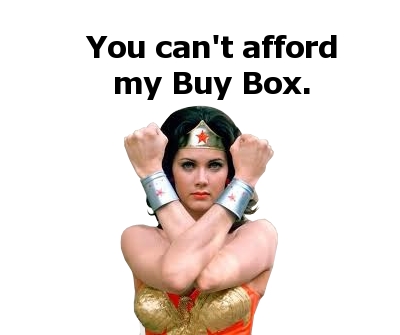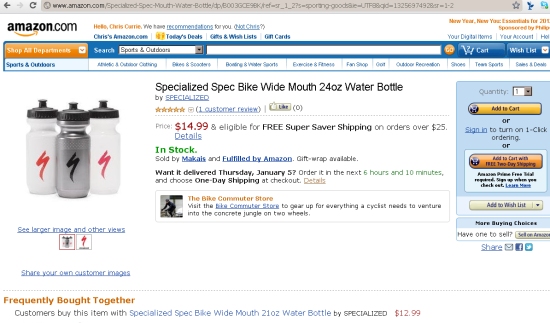I took issue yesterday with a peculiar letter Specialized’s Mike Sinyard recently sent to his bicycle dealers, urging them to stop selling all products from Easton, Fizik, Shimano, and other brands, because products from those companies may appear for sale on Amazon. You know, like Specialized products sometimes do.
Yesterday, I was simply struggling to comprehend the demeaning tone of the letter, which treated dealers like children, hiding under their beds, terrified of technology and the boogieman that is the Internet. After re-reading that last part, the not-so-thinly-veiled threat to his own dealers a half dozen times in near shock, I’m finally able to look at the details of Sinyard’s letter, and I’m pretty sure even he doesn’t understand how bad Amazon really is. In his effort to serve only his own purposes, he doesn’t paint a full picture of the situation. If you’re going to attack Amazon, this is how you’re supposed to do it:
Sinyard sounds the alarm against a particular Amazon app that lets people scan bar codes to compare prices and shop with their phones. I’d like to first point out that apps capable of doing this have been available for a long time. Google Goggles can do this, as can Barcode Scanner, and other bar code reading apps, and most will show you shopping results across the whole web, not just Amazon. So I’d like to call on all Specialized dealers to remove themselves from Google maps and anything related to Google and don’t even let your kids use it to help with their homework. Whew! I hope that was in time.
Mobile shopping is a reality that isn’t limited to Amazon, and isn’t going away. To declare it evil and urge your followers to pray to the big red “S” to make it disappear is certainly one strategy for dealing with technology. But if we’re relying on magical thinking, their collective energies are probably better spent hoping Trek headquarters gets attacked by a dragon.
Again, I think I’m particularly pissed off about this because Amazon is a threat to all other retailers, but Amazon is also an opportunity. The reality of the situation is complicated. If you’re not willing to have an intelligent discussion with your business partners (not that anyone at Specialized sees their followers dealers as “partners,” but that’s technically what they should be), then both of you end up in the dark. And the stakes are too great here to let that happen.
See, we really do need a strategy for dealing with Amazon. A real one. In fact, Amazon is so bad that one of my biggest problems with Sinyard’s argument is how dangerous simplistic and self-centered it is. He doesn’t articulate what the real problem is with Amazon, because that wouldn’t serve his more near-sighted purposes. But that’s what the bike industry as a whole could use: more honesty about the Internet. The threat of Amazon is something every retailer needs to recognize and develop a strategy to address, but selling only Specialized products is not a winning strategy, long term. In glossing over them in a rush to paint his own competition as bad guys, Sinyard misrepresents the real issues and facts about Amazon, which are actually worse than he imagines.
OK, so the main premise to any argument against Amazon’s new app is that people will use it to find lower prices at Amazon, then leave your store and buy the thing online. That’s certainly possible, partially because Amazon’s scale lets it live off of virtually no margin. But to combat that, you need to learn how Amazon works, not run and hide.
Much of the bike stuff being offered on Amazon isn’t being sold directly by Amazon. It’s being sold by other small retailers. Sinyard either doesn’t know this, or doesn’t care to mention it, because his primary motivation is kicking guys like Easton in the nuts, which is good theater but does jack shit to help bike dealers. Yes, a lot of the bike stuff on Amazon is being sold by small businesses who are listing their products on Amazon through Amazon’s Seller Central program. These are not large companies. Most are smaller than the larger brick-and-mortar IBDs.
These retailers can sell for less because their overhead is so much lower than an IBD, right? Well, many of them are IBDs, who also have the expenses of trying to manage online sales, so right out of the gate their margins are in trouble. But let’s assume they’re only selling online and have very little overhead–like they don’t pay to heat their buildings or operate out of the trunk of a car or something–and let’s assume they’re also pushing major volume and are getting huge discounts from suppliers, OK? By the way, boogieman-mongers like to pretend this happens more than it does. I’ve seen “off-book” pricing and I’ve had off-book pricing, but it’s far rarer than most anti-online voices would prefer IBDs realize. I ran a single store that was doing more than $3-million in sales almost entirely online, and I was aware of brick-and-mortar only dealers who were getting the same prices I was, sometimes better. The big off-book discounts are always on horrible shit that a good shop shouldn’t be selling anyway. The idea that people are buying current, in-season product for half what you are is a convenient myth, perpetrated by n’er-do-wells who make more money the less retailers know, and the more they fight amongst themselves. But for the sake of argument: even for a best-case scenario dealer with little overhead and great pricing, making any money selling on Amazon is not easy. In fact, it’s nearly impossible.
For one thing, you don’t “sell” things on Amazon. You compete for exposure. Amazon actively pits retailers against one another for their own advantage by making those retailers compete for the coveted Amazon “Buy Box.” This is one of the many secret sauces making Amazon the McDonald’s of processed shit retail that it is, and I’ll try to break it down as simply as possible, because it’s fucking brilliant and evil, all at once. It’s evilliant:
- Small retailers decide to sell on Amazon for the massive exposure it gives them
- Amazon takes 15% out of your ass just for listing a bike part or bike
- There’s also a monthly fee of $39.99, but after the 15%, that feels like a kiss on the cheek
- To have your product actually visible to most shoppers, it has to appear in the “Buy Box,” and to get it there, you have to compete with every other retailer–including Amazon–and guess what the main criteria is for “winning the Buy Box”? (Did you guess “lowest price”?)
- Because you’re playing on Amazon’s court, and they’re allowed not just to throw the ball at the hoop, but also to move the fucking hoop to where the ball is headed, they can at any time choose to step in and price match that lowest price, stealing the sale from the smaller retailer
- Oh, it gets better: do you think Amazon isn’t gathering all of the sell-through and pricing data and making calls to vendors themselves asking for quantity pricing on a zillion cycling computers because–thanks to the retailers–Amazon knows they can sell 200 of them in a week, if the price is right? (Hint: Of course they are. If you sell on Amazon, you’re also a buyer for Amazon, silly. They just don’t pay you.)
So the first thing to understand is that both Amazon and Specialized are oppressive here. The ones losing out are small retailers. Those not selling online at all will soon have missed the entire bus and will eventually be relegated to the Fix-it Shop on Sesame Street, and those relying on Amazon for sales are basically chewing off their own arms and becoming the Fix-it Shop on Sesame Street. Yes, Amazon is a losing proposition for most retailers, and not selling products online is a dead end street. But don’t go spending quality time in the bathtub with a toaster just yet. Plenty of retailers prove there’s an answer to Amazon–I mean besides crawling under the big red Luddite rock and waiting for this whole “Internet” fad to pass.
If I’m not too sleeply, I’ll offer a plan for fighting back tomorrow.



Sorry, the comment form is closed at this time.